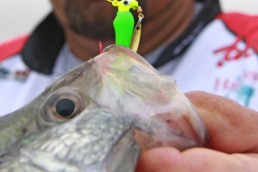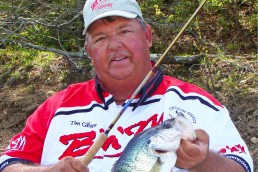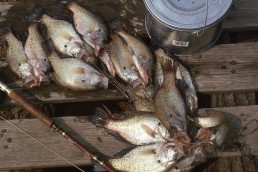Spring Crappies for You
SHARE THIS POST
Ice-covered lakes are thawed and hot fishing action is in progress; spawning crappies are going shallow in the North while southern crappies are in post-spawn. Mother Nature determines the time, and it’s your job for the when and where.
Plan #1
There are many ways to catch spawning crappies. Casting, jigging, drifting, dipping minnows and using a slip-float minnow rig are just a few options—use the one you enjoy. If your technique catches fish, it’s the way to go.
What if you don’t have a favorite method or just want a change? There are two tactics that are successful during the spring spawn.
The first technique is a minnow and float. Fishing is done from the bank or from a boat. Calm days are best from a boat or a fisherman can anchor to keep the boat in place. A minnow/float combo is good for experienced or young or inexperienced fishermen. Family and friends can have a blast catching fish without having to constantly cast. Watching a floater slowly move away and edge downward is fun whether you’re 3 years old or 63 years old.
Equipment can be simple, but should be of average to good quality, with no “cartoon character” outfits. The reel needs to operate smoothly and be easy to use. A $30 outfit with a good push-button reel is the minimum investment. It will cast, retrieve and last much longer than a kiddie’s version. A 5-foot pole may work for a young person, but an adult will do better with a 7- or 8-foot, medium or medium-light-action pole. The length allows the long-distance casts.
The business end of the line should include a sharp hook, split shot and float. The float can be a stationary clip-on type if fish are shallow. A slip float should be used when fishing deeper than 4 feet. A bobber-stop is used to set the depth, a cast is made, the float hits the water and the line flows through it until it gets to the stop. Again, this setup allows long casts and fishing at any depth. The minnows complete the system, and should be active and small (about 2 inches).
Are you enjoying this post?
You can be among the first to get the latest info on where to go, what to use and how to use it!
Plan #2
Most crappie fishermen use slightly more aggressive tactics. Casting a spinnerbait to shallow water is an example of going to the fish instead of waiting for them to come to you. Casting from a boat is an excellent method for finding the shallow fish. Working a bank while casting and retrieving is a quick way to find the type of areas, bottom contour and cover where crappies prefer to be on a particular day. Like with all casting, a smooth spinning or spincast outfit should be used.
There are many good spinnerbaits for crappies. A small Johnson Beetle Spin has been around for decades. It still works, but so do the newer styles. The offset spinners allow for a slower retrieve and are semi-weedless compared to an open hook.
Finding the right spot
The reason our sport is called “fishing” instead of “catching” is because fish don’t always do what we predict, and they don’t always bite. Start by fishing the northern areas of a lake first, especially coves. These are the first to warm. Crappies on the south side may spawn a week or two later.
Experience tells us that crappies prefer rocks, pea gravel, weeds and a protected bank for spawning. These locations are best for making beds and protecting eggs. Other locations for spawning include mud bottoms with lots of cover, humps that have both shallow and deep water and “oddball” places like horizontal concrete bridge pilings. In some lakes, spawning takes place in very deep water on humps and similar spots too. Different lakes and different water conditions mean you have to do some searching. The good news is when you find a pattern it should be the same all over the lake.
Other tips
Don’t stay too long in one area during the spring and early summer. If fish are there, they’ll quickly attack a bait. When you find an area with fish it’s time to concentrate on that spot. Take your time and work every inch of a location. When action slows, try a different bait, speed or color. And don’t forget the scent. An attractant, even when using a minnow, might draw several more strikes.
MWO
SHARE THIS POST
Did you enjoy this post?
You can be among the first to get the latest info on where to go, what to use and how to use it!
Tim Huffman
Tim Huffman specializes in crappie fishing, is editor for two crappie magazines, as well as writing for several others. In 2018, he published his sixth book, Limiting Out for Crappie, available at Amazon. His first article appeared in MidWest Outdoors in 1988.



